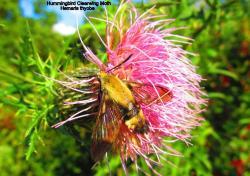Thank-you ALL so much for the warm welcomes

I have so much to ask you all but have been panicking for the past 24 hrs over the bunchflower that has decided to flower and, of course, I put it in a place that is easily accessible and hard to protect! Yes, Melanthium virginicum is supposed to be toxic but the deer don't read those memos!
David, no need to apologise. I'm happy to find so many people who are passionate about the natives and equally passionate about eliminating the invasives!
J, that is an awesome picture! I almost went off the road the other day...I think there are stands of tall thistle along Rt 7...they were absolutely beautiful! Interesting thing is..I have grown, from seed, many native so-called pollinator species....columbine, hairy beardtongue, Chelone sp etc etc but where do the butterfies go? They go to the dandelions, thistles and my daughter's super aggressive bed of red rocket/purple rooster monardas!
Aspen, I think I live (as the crow flies) just SW of you up near Mt Weather....here the deer will take EVERYTHING including trilliums and fern...they even tried to eat a blue cohosh this year! The species that have not been touched are the mega invasives such as bittersweet, stiltgrass etc and very very few natives such as Va bluebells and columbine. The property was terribly disturbed when we arrived...I think the previous owners had set it up to trap and hunt deer (no, I do not hunt) so the deer trails and most of the areas around them were void of anything but stiltgrass. I unwittingly and stupidly went about pulling the stiltgrass and covering with mulch...like laying out a red carpet for the deer! 3 yrs later? I took EVERY tree trunk I could find and laid them haphazardly across one of the worst deer trails...I didn't lay them flat because there were natives, mainly cohosh and bloodroot that were still present but were trampled every year and hence invisible, but I layered them about 3ft high and not only has this stopped the deer from using this trail...they don't seem to like putting their hooves where they can't see the ground but the leaves that were trapped by the logs have effectively blocked the stiltgrass AND the Lindera benzoin which grows everywhere has actually managed to put out lower leaves and this is now shading the trail....stiltgrass does not like shade. I know the deer are still present but I'm hoping that if they don't have smooth trails across this tiny patch of land that they will have to tread different paths each time...some areas will have a chance to recover.
I have temporarily cordoned off some patches with stakes and fishing line and attached some organza bags to the fishing line (hoped they looked like the white of a deer's tail) and it has worked, momentarily...until they figure out they can knock everything thing down in an instant...I'm hoping it'll work so the bees will get some flowers this summer and the little witch hazel cuttings can actually keep some of their leaves and grow a bit!
Wow, I am rambling...
Just so happy to have found this forum!
You're definitely in the right forum!
